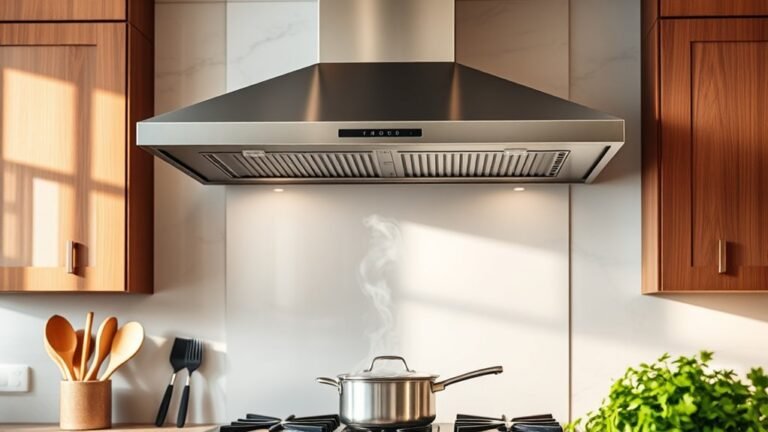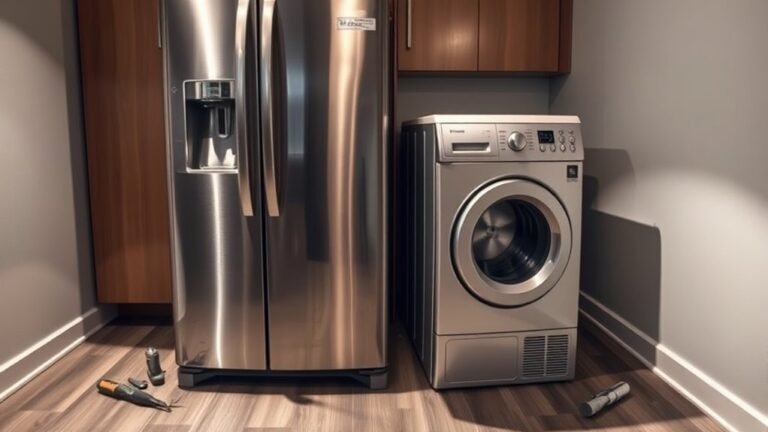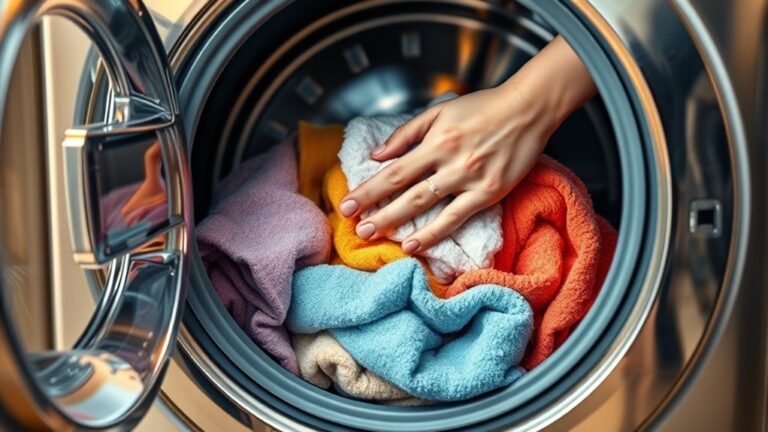Seasonal Maintenance Tips for Sink
To keep your sink shining and clog-free year-round, start with spring cleaning by removing hard water stains using vinegar. In summer, check for leaks and tighten fittings. Come fall, clear drains and prevent clogs with baking soda and vinegar flushes. In winter, protect pipes from freezing with insulation and keep faucets covered. Don’t forget to regularly inspect seals and replace worn parts to avoid costly damage. Stick around to discover how to maintain your garbage disposal and prevent mold too.
Spring Cleaning: Removing Hard Water Stains and Deposits

Since hard water stains and deposits can build up over time, spring is the perfect season to tackle their removal. You don’t have to let those stubborn marks limit your sink’s appearance or function. Start by using a solution of white vinegar and water to break down hard water deposits gently but effectively. Apply it to the affected areas, let it sit for a few minutes, then scrub with a soft brush or cloth. This simple routine frees your sink from mineral buildup, restoring its shine and preventing clogs. By staying on top of hard water stain removal now, you give yourself the freedom to enjoy a clean, hassle-free sink all year long—no more worrying about tough stains holding you back.
Summer Care: Checking for Leaks and Cracks
During summer, you’ll want to inspect your faucet connections carefully for any leaks or loose fittings. Don’t forget to check the drain and pipes underneath the sink for cracks or signs of moisture. Catching these issues early can save you from costly repairs down the line.
Inspect Faucet Connections
Take a close look at your faucet connections this summer to catch any leaks or cracks early. Regular faucet maintenance is key to avoiding water waste and costly repairs. Start by turning off the water supply, then carefully inspect each connection point for signs of wear or damage. Tighten any loose fittings but avoid overtightening, which can cause cracks. Look for corrosion or mineral buildup that might weaken seals over time. If you spot even minor leaks, address them immediately to preserve your freedom from bigger plumbing issues down the line. Performing a thorough connection inspection yourself empowers you to maintain control over your sink’s condition and guarantees smooth, uninterrupted use throughout the season. Staying proactive with your faucet maintenance lets you enjoy worry-free water flow all summer long.
Examine Drain and Pipes
Even if your drain and pipes seem fine, it’s important to check them regularly for leaks and cracks to prevent costly damage. Performing a thorough drain inspection can save you from unexpected repairs and water waste. Take a moment to look under your sink and feel along the pipes for any moisture or signs of corrosion. Small cracks or loose connections can quickly turn into bigger problems if ignored. Regular pipe maintenance not only extends the life of your plumbing but also keeps your home safe and comfortable. By staying proactive, you’re freeing yourself from emergency fixes and letting your sink work smoothly all summer long. Make this simple check a part of your seasonal routine to enjoy worry-free water flow.
Fall Preparation: Clearing Drains and Preventing Clogs

As leaves fall and the weather cools, your sink’s drains can quickly become clogged with debris and buildup. Staying ahead with proper drain maintenance is key to clog prevention, letting you enjoy hassle-free water flow. You’ll want to clear out leaves, grease, and other debris that might sneak into the drain during autumn.
Autumn leaves and grease can clog your drains—stay proactive with regular cleaning for smooth water flow.
Here’s how to keep your drains clear this fall:
- Remove visible debris from the drain cover regularly to prevent blockages.
- Flush your drains with hot water mixed with baking soda and vinegar to break down grime.
- Use a drain snake or plunger for stubborn clogs before they escalate.
Winter Protection: Preventing Frozen Pipes and Damage
When temperatures drop, your sink’s pipes are at risk of freezing and cracking, which can lead to costly repairs. To protect your freedom from unexpected plumbing hassles, start by applying pipe insulation to exposed pipes. This simple step creates a barrier against the cold, reducing the chance of freezing. Don’t forget faucet winterization—drain outdoor faucets and cover them with insulated caps to prevent ice buildup. Inside, keep cabinet doors open to allow warm air to circulate around your pipes. If you’re away during winter, consider leaving a trickle of water running to keep things moving. Taking these proactive measures lets you enjoy the season without worrying about sink damage, ensuring your home stays safe and your pipes stay intact throughout winter’s chill.
Regular Inspection of Faucets and Seals

You’ll want to regularly check your faucets for any leaks that could waste water or cause damage. Take a close look at the seals to make sure they’re still tight and intact. Catching these issues early can save you from costly repairs down the line.
Checking for Leaks
How often do you check your faucets and seals for leaks? Staying on top of leak detection frees you from unexpected water damage and costly repairs. A routine plumbing inspection lets you catch drips before they become floods, protecting your home and your peace of mind.
To keep your sink leak-free, focus on these areas during your check:
- Examine faucet bases and handles for moisture or corrosion
- Look under the sink for pooling water or damp spots
- Listen for any persistent dripping sounds even when faucets are off
Seal Integrity Assessment
A thorough seal integrity assessment involves regularly inspecting your faucets and seals to confirm they remain tight and functional. Different seal types, like rubber O-rings or silicone gaskets, need your attention since wear can cause leaks or reduced efficiency. By performing routine seal maintenance, you guarantee your sink’s components stay secure, preventing water damage and saving you from costly repairs. Check for cracks, brittleness, or displacement around seals and faucet joints. If you notice any degradation, replace seals promptly to maintain peak performance. Staying proactive with these simple inspections gives you the freedom to enjoy your sink without worries, keeping everything running smoothly and extending the lifespan of your fixtures. This small effort keeps your water system reliable season after season.
Using Natural Cleaners to Maintain Shine
Although commercial cleaners might seem convenient, using natural cleaners is often better for maintaining your sink’s shine without harsh chemicals. You can embrace eco friendly solutions that not only protect your sink but also give you the freedom to avoid toxins. Homemade mixtures are simple, effective, and budget-friendly, letting you control what touches your surfaces.
Try these natural options to keep your sink gleaming:
- A paste of baking soda and water gently scrubs stains without scratching.
- White vinegar wipes dissolve mineral deposits and restore sparkle.
- Lemon juice naturally disinfects and leaves a fresh scent.
How to Address Slow Drainage Effectively
Keeping your sink shining with natural cleaners is just one part of maintaining it; slow drainage can quickly become a frustrating issue if left unchecked. To tackle slow drainage effectively, start by clearing visible debris from the drain. You can then use simple drainage solutions like a mixture of baking soda and vinegar to break down buildup naturally. If that doesn’t do the trick, it’s time to reach for basic plumbing tools like a plunger or a drain snake to remove deeper blockages. Avoid harsh chemicals that could damage your pipes or harm the environment. Regularly addressing slow drainage not only keeps water flowing freely but also gives you the freedom to enjoy a hassle-free sink without costly repairs down the road.
Maintaining Garbage Disposals for Optimal Performance
Keeping your garbage disposal in top shape means regular cleaning and knowing what not to put down it. You’ll want to avoid common blockages by following proper usage guidelines. With a few simple habits, you can prevent problems and extend your disposal’s life.
Regular Cleaning Techniques
Since garbage disposals handle a lot of kitchen waste, regular cleaning is essential to prevent clogs and odors. You’ll want to incorporate effective sink sanitization techniques into your daily maintenance routine to keep things running smoothly and your kitchen smelling fresh. Here’s a simple way to maintain freedom from mess and hassle:
- Grind ice cubes and citrus peels weekly to clean blades and freshen the disposal.
- Pour a mixture of baking soda and vinegar down the drain, let it fizz, then rinse with hot water.
- Run cold water while using the disposal to solidify grease and flush debris efficiently.
Avoiding Common Blockages
Although garbage disposals are designed to handle kitchen waste efficiently, certain materials can cause blockages that disrupt their performance. To keep your sink running smoothly, focus on effective blockage prevention by avoiding fibrous items like celery, potato peels, or coffee grounds. These can tangle or compact, making drain maintenance tougher. Also, steer clear of grease and oil—they solidify and clog pipes. Regularly flushing your disposal with cold water helps wash away debris before it causes issues. For added care, grind small amounts of ice and citrus peels occasionally; this naturally cleans and sharpens the blades. By staying mindful of what goes down your disposal and committing to simple upkeep, you’ll enjoy a free-flowing sink and avoid the hassle of stubborn blockages.
Proper Usage Guidelines
When you want your garbage disposal to work efficiently and last longer, following proper usage guidelines is essential. Respecting good sink etiquette and practicing water conservation can keep your disposal running smoothly without frequent repairs. Here’s what you should keep in mind:
- Always run cold water before, during, and after grinding to solidify fats and flush debris.
- Avoid putting fibrous, starchy, or hard items like celery, potato peels, or bones, which can jam or dull blades.
- Don’t overload the disposal; feed scraps gradually to prevent clogging.
Tips for Avoiding Mold and Mildew Build-Up
If you want to keep your sink area fresh and hygienic, preventing mold and mildew build-up is essential. Start by ensuring good ventilation around your sink to reduce moisture, a key factor in mold prevention. Wipe down surfaces regularly to remove water droplets and avoid stagnant moisture. Using a mild bleach solution or vinegar can be an effective mildew treatment, but make sure to rinse thoroughly. Avoid leaving wet sponges or cloths near the sink, as they’re breeding grounds for mold. Check for leaks and fix them promptly since constant dampness encourages mildew growth. By following these simple steps, you’ll maintain a clean, mold-free sink environment that supports your freedom to enjoy a healthy, worry-free space.
Replacing Worn Out Parts Before They Fail
One of the best ways to avoid costly repairs and inconvenience is to replace worn out sink parts before they fail completely. By embracing preventative maintenance, you stay ahead of problems, ensuring your sink works smoothly without unexpected breakdowns. Timely replacements give you freedom from emergency fixes and water damage stress.
Replace worn sink parts early to prevent costly repairs and avoid unexpected breakdowns.
Keep an eye on these common parts that may need swapping out:
- Faucet washers and O-rings that cause leaks
- Drain stoppers and seals that lose effectiveness
- Supply lines that wear thin or crack
Frequently Asked Questions
What Is the Best Type of Sink Material for Durability?
When choosing a sink for durability, you’ll want to contemplate stainless steel or composite materials. Stainless steel is tough, resists rust, and handles daily wear effortlessly, perfect if you want freedom from constant upkeep. Composite materials, like granite composites, offer incredible strength and scratch resistance while giving you a stylish look. Both options let you enjoy your kitchen without worrying about damage, so pick what matches your lifestyle and freedom to live hassle-free.
How Often Should I Replace My Kitchen Sink?
Think of your kitchen sink like a trusty old bike—it serves you well until rust or cracks slow you down. Typically, the average sink lifespan is about 15-30 years, depending on material and care. You should consider replacement indicators like persistent leaks, stains that won’t fade, or structural damage. Don’t wait until your sink’s freedom to flow is compromised; swapping it out when these signs appear keeps your kitchen running smoothly and stress-free.
Can I Install a Water Softener to Improve Sink Maintenance?
You can definitely install a water softener to improve your sink maintenance. The water softener benefits include reducing mineral buildup, which means fewer clogs and longer-lasting fixtures. When installing, make sure to choose a system compatible with your plumbing and follow installation tips like checking for proper drainage and regular salt refills. Taking these steps gives you the freedom to enjoy cleaner, smoother water without constant repairs or hassle.
What Are the Signs of a Faulty Sink Drain Assembly?
Like a ship struggling against a storm, your sink’s drain assembly shows signs when it’s failing. If you notice frequent drain clogs or water pooling beneath, you’re likely facing assembly leaks. These leaks can limit your freedom to enjoy a hassle-free kitchen, so don’t ignore persistent dripping sounds or slow drainage. Catching these signs early lets you regain control and keep your sink working smoothly without unexpected disruptions.
How Do I Prevent Sink Odors Without Harsh Chemicals?
To prevent sink odors without harsh chemicals, you can rely on natural deodorizing methods like pouring baking soda followed by vinegar down the drain, then flushing with hot water. Regularly using sink cleaning techniques such as scrubbing the drain stopper and rinsing with lemon juice helps too. These simple steps keep your sink fresh and free from unpleasant smells, letting you enjoy a clean kitchen without feeling trapped by harsh cleaners.






